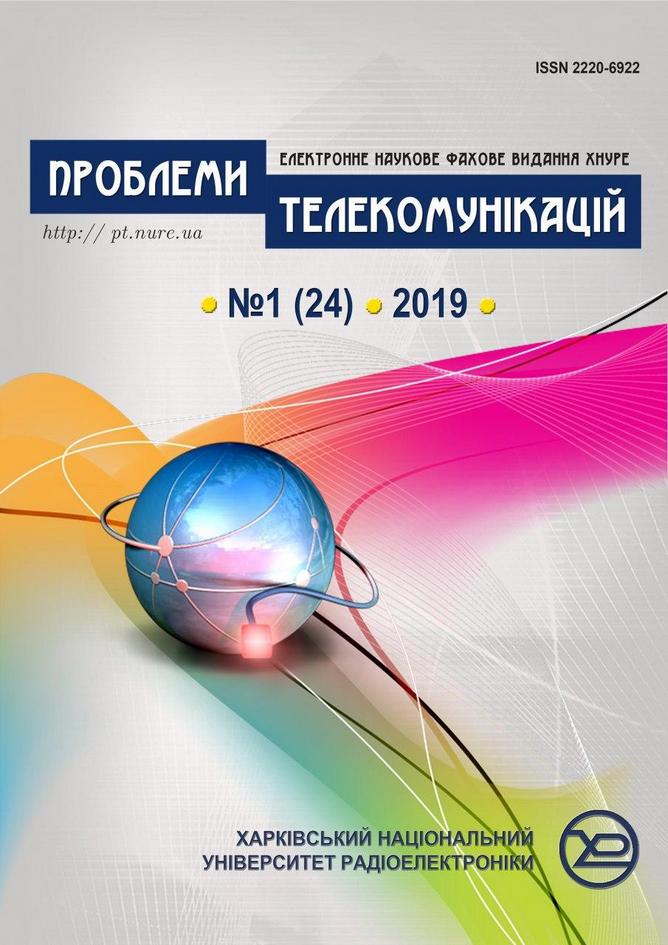The method of secure routing of multifractal traffic
DOI:
https://doi.org/10.30837/pt.2019.1.02Keywords:
Method, Routing, Network, Self-similarity, Path, Cost, FractalityAbstract
The paper proposes a solution to the current problem of ensuring the quality of service of infocommunication networks, taking into account network security, which provides a greater number of services with high efficiency. In the paper, experiments were conducted to analyze the effect of fractality and vulnerabilities on the quality of service parameters. The safety route provision method for the transfer of multifractal traffic in infocommunication networks was proposed. The proposed method takes into account the specified limits on the delay time and the number of lost packets for each type of traffic quality service. The results of the analysis show that the overload during traffic transmission on a switched channel occurs due to the multifractal characteristics of traffic and the presence of an attack. This method is based on a special procedure for calculating the cost of routes with the further use of these data when choosing the shortest paths. In this paper, an experiment was conducted to analyze the effectiveness of the proposed method under conditions of multifractal traffic and the presence of attack traffic. The results showed that the use of the proposed method allows to reduce latency and jitter in the network, as well as to increase the effectiveness of blocking attack traffic.References
Acharya H. S., Dutta S. R., Bhoi R. The Impact of self-similarity Network traffic on quality of services (QoS) of Telecommunication Network. International Journal of IT Engineering and Applied Sciences Research (IJIEASR). 2013. Vol. 2. P. 54-60.
Lakhmi P. D., Sanjay K.P. Fractal Behavior of TCP/IP in Network Traffic. International Journal of Advance Computing Technique and Applications. 2015. Vol. 3, No. 1. P.124-128.
Czarkowski M., Kaczmarek S., Wolff M. Influence of Self-Similar Traffic Type on Performance of QoS Routing Algorithms. INTL Journal of electronics and telecommunications. 2016. Vol. 62, No. 1. P. 81-87. DOI: https://doi.org/10.1515/eletel-2016-0011.
Shelukhin O. I., Smolskiy S.M., Osin A.V. Self-Similar Processes in Telecommunications. New York : John Wiley & Sons. 2007. 334 p.
Ageyev D.V., Salah М.Т. Parametric synthesis of overlay networks with self-similar traffic. Telecommunications and Radio Engineering. 2016. Vol. 75, No. 14. P. 1231-1241. DOI: 10.1615/TelecomRadEng.v75.i14.10.
Pietro R. D., Mancini L. V. Intrusion Detection Systems. Springer Science & Business Media. 2008. 250 p.
Riedi R.H. Multifractal processes. Long Range Dependence: Theory and Applications. / In eds. Doukhan P., Oppenheim G., Taqqu M.S. Birkhuser. Springer Science & Business Media. 2002. 720 p.
Kirichenko L.O., Radivilova T.A., Kayali E. Routing calculation value in the MPLS network based on fractal properties of traffic. Automated control systems and automation equipment. 2012. Vol. 161. P. 116-121.
Kirichenko L., Radivilova T., Kayali E. Modeling telecommunications traffic using the stochastic multifractal cascade process. Problems of Computer Intellectualization / ed. K. Markov, V. Velychko, O. Voloshin. Kiev–Sofia: ITHEA. 2012. P.55–63.
Betker A., Gamrath I., Kosiankowski D., Lange C., Lehmann H., Pfeuffer F., Simon F., Werner A. Comprehensive topology and traffic model of a nationwide telecommunication network. IEEE/OSA Journal of Optical Communications and Networking. 2014. Vol. 6, No. 11. P. 1038–1047. DOI: 10.1364/JOCN.6.001038.
Kirichenko L., Radivilova T., Alghawli A. S. Mathematical simulation of self-similar network traffic with aimed parameters. Anale. Seria Informatică. 2013. Vol. 11, No. 1. P.17-22.
Medhi D., Ramasamy K. Network Routing, Second Edition: Algorithms, Protocols, and Architectures. 2nd Edition. The Morgan Kaufmann Series in Networking. Cambridge, MA, USA: Elsevier Inc. 2018. 1018 p.
Donghyuk H., Jong-Moon C. Self-Similar Traffic End-to-End Delay Minimization Multipath Routing Algorithm. IEEE Communications Letters. 2014. Vol. 18, No. 12. P. 2121-2124. DOI: 10.1109/LCOMM.2014.2362747.
Kirichenko L., Radivilova T., Bulakh V. Machine Learning in Classification Time Series with Fractal Properties. Data. 2019. Vol. 4(1), No. 5. P.1-13. DOI: https://doi.org/10.3390/data4010005.
Kirichenko L., Radivilova T. Analysis of network performance under self-similar system loading by computer simulation. Bionics intelligence. 2008. Vol. 1, No. 68. P. 158–160.
Lemeshko O. V., Yeremenko O. S. Dynamics Analysis of Multipath QoS-Routing Tensor Model with Support of Different Flows Classes. Smart Systems and Technologies (SST): Proceedings of the International Conference, Osijek, Croatia, 12-14 Oct. 2016. IEEE, 2016. P. 225–230. DOI: https://doi.org/10.1109/SST.2016.7765664.
Downloads
Published
Issue
Section
License
Copyright (c) 2019 Tamara Radivilova

This work is licensed under a Creative Commons Attribution-NonCommercial-ShareAlike 4.0 International License.
Authors who publish with this journal agree to the following terms:- Authors retain copyright and grant the journal right of first publication with the work simultaneously licensed under a Creative Commons Attribution License that allows others to share the work with an acknowledgment of the work's authorship and initial publication in this journal.
- Authors are able to enter into separate, additional contractual arrangements for the non-exclusive distribution of the journal's published version of the work (e.g., post it to an institutional repository or publish it in a book), with an acknowledgment of its initial publication in this journal.
- Authors are permitted and encouraged to post their work online (e.g., in institutional repositories or on their website) prior to and during the submission process, as it can lead to productive exchanges, as well as earlier and greater citation of published work (See The Effect of Open Access).

